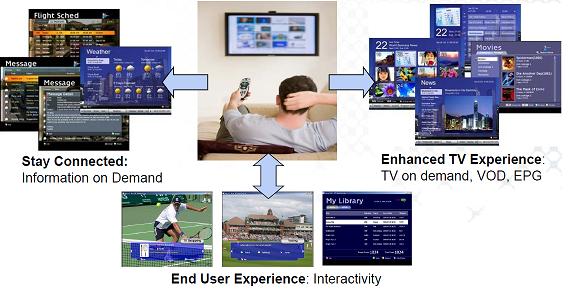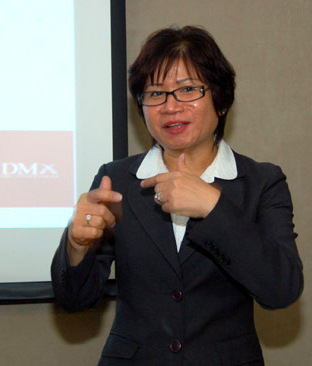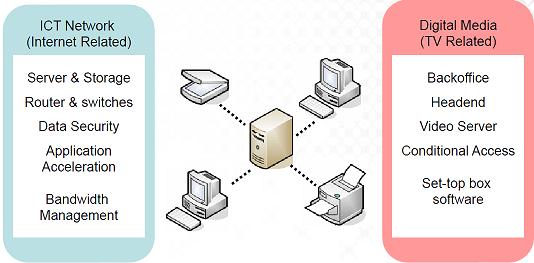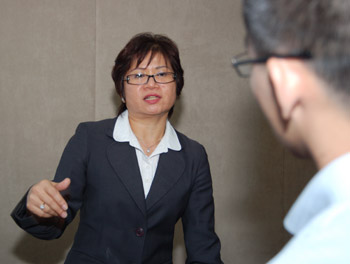
DMX CEO Jismyl Teo was at CIMB yesterday to throw more light on its niche position in the huge and complex world of information communications technology (ICT) and Internet digital media solutions.
In a nutshell, the company designs and installs architecture that connects equipment from different brands of manufacturers to run as a system.
For ICT segment, such equipment ranges from servers and storage, routers and switches, with services in data security, application acceleration and bandwidth management.

Technology replacement has resulted in greater demand for system integration, said Ms Teo.
Margins may be low for ICT, but the advantage of retaining MNC customers like Samsung is they help DMX to expand to overseas markets.
On the other hand, equipment for digital media solutions segment is cable TV-related such as video headend, video servers, with network solutions for conditional access, set-top box software and back office.
Its customers are diverse: ranging from cable TV operators, telecom operators, banks and other large MNCs such as Lenovo, Samsung, Dell and even Wilmar, to China Southern Airlines, hotels and hospitals.
So where exactly is DMX’s niche?
It recently renewed a 3-year managed security services (MSS) contract with MTR Corp, the largest transport operator in Hong Kong.
DMX will provide its full suite of MSS to the MTR Corp, including 24X7 incident management and security monitoring.
This service combines the collection, correlation, management, early warning and detection of potential threats with 24x7 expert security analysis at DMX’s Security Operation Center in Hong Kong.
MSS is one of its 5 business segments, but the two key contributors to DMX’s top line come from the provision of infrastructure solutions and digital media solutions.
This has been driven by growth in China on government mandate to migrate the country’s analogue TV broadcast systems to digital by 2014, but the company has also been making headway in South Korea, Indonesia and India, said Ms Teo.

1Q2011 revenue had grown 35.3% to US$64.4 million, helped by major contract wins from various Korean conglomerates and Indonesian telecom operators.
Revenues outside China had surged 85% year-on-year to US$17.8m, accounting for 72% of group revenues, and Ms Teo expects this to drop to below 70%.
63% of group revenue is currently from the provision of infrastructure enabling solutions and 37% from digital media sales, but Ms Teo wants to increase the contribution from digital media as it is relatively more lucrative.
DMX has an internal target of sustaining earnings CAGR at 20% or more over the next 5 years.
Here is a summary of questions raised by investors at the meeting and Ms Teo’s replies.

Q: Who are your main competitors?
For ICT, Digital China, ZTE and one or two local players also carry Cisco equipment.
Q: Your net margin of 3% is thin. What is your ideal net margin?
We are trying to move back to 5.7% by focusing on higher margin services rather than infrastructure.
Q: Why did you issue ADRs when TDRs more relevant since your market is in China?
We wanted to increase our profile with US investors. Secondly, we were not raising funds, which a TDR listing requires.
Q: What is your liability when your cyber security customers' security is breached?
We have yet to see any customers being exposed that which we cannot detect.
Q: Did you pay dividends in the past few years?
Our last dividend was in 2006. Japan’s second largest telco, KDDI, became a majority (51%) shareholder in 2009 and it would not make sense to return some of the cash to KDDI via a dividend since it is not in need of such cash.
Q: Do you intend to pay dividends in the future?
We leave it to the independent directors to decide whether or not to pay dividends for 2011. KDDI is the decision maker but independent directors look after the interest of the minority shareholders.
Related story: DMX: Targeting 20% Annual Growth In Revenue For Next 5 Years







